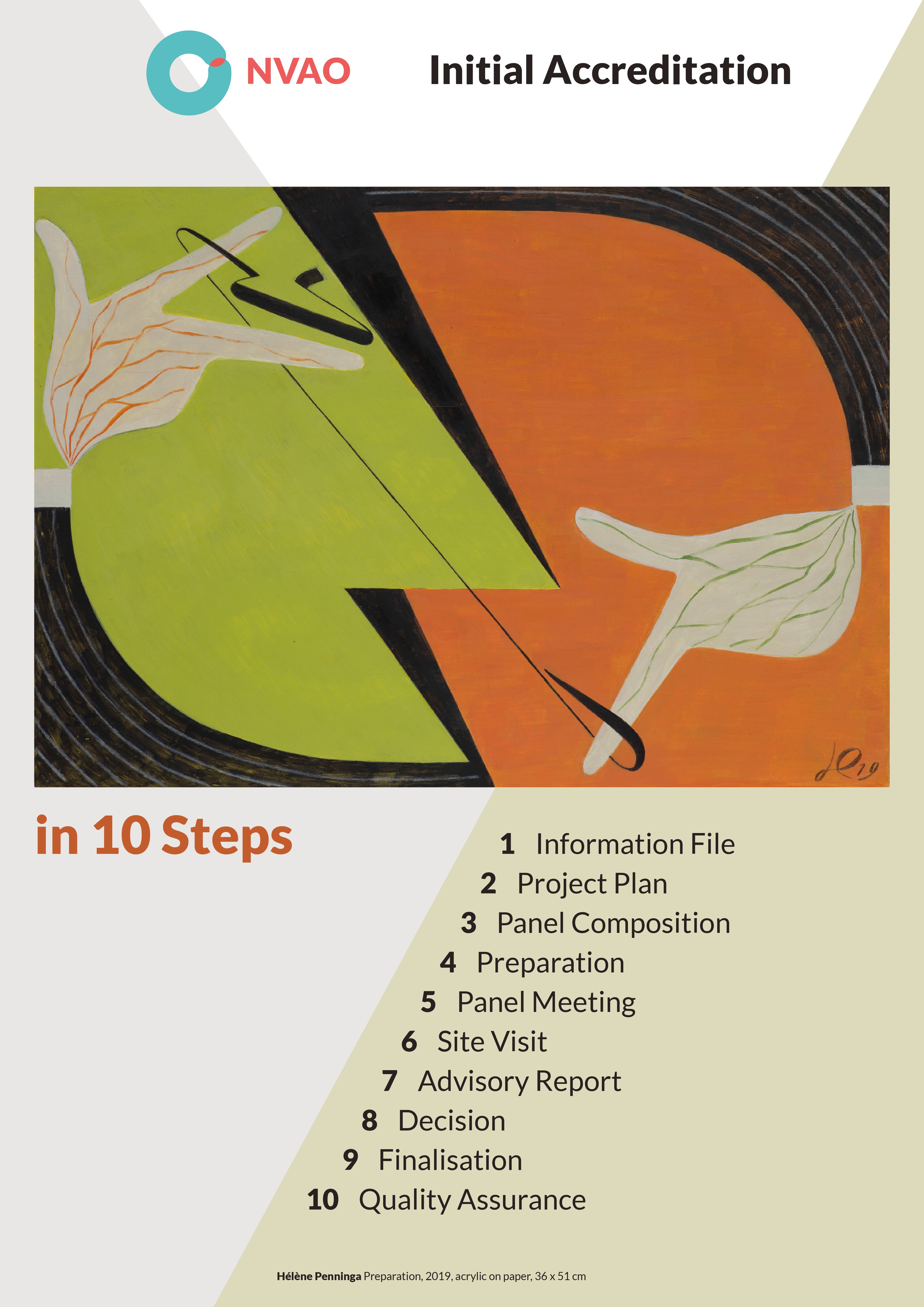Initial Accreditation
To obtain accreditation from the Accreditation Organisation of the Netherlands and Flanders (NVAO), a new degree programme must successfully complete the initial accreditation procedure. Only after passing this quality assessment may the higher educational institution award the legally protected degrees for the programme.
General info
Initial Accreditation in 10 Steps
The procedure for a new programme differs slightly from that of existing, already accredited programmes. An initial accreditation (TNO) is an assessment of the programme's design. Once accredited, the new programme becomes subject to the regular accreditation cycle.
An NVAO panel of independent experts assesses the quality of the new programme during a site visit to the university or university of applied sciences. A peer discussion forms the basis of the assessment and results in an advisory report.
As the gatekeeper of quality in higher education, NVAO appoints the panel members for the initial accreditation procedure. Institutions may propose candidates for panel membership.
NVAO aims to complete the procedure within six months. With over 20 years of experience in organising TNO procedures, we have developed a streamlined 10-step process. This step-by-step plan outlines the distinct phases that the institution, the panel, and NVAO go through together—from a clearly defined starting point to a conclusion. The result is a thorough and efficient assessment procedure that ensures institutions receive a clear outcome regarding the recognition of their new programme.

Initial accreditation
During the initial accreditation procedure, the panel assesses the programme design submitted by the institution. This plan provides a clear overview of the intended learning outcomes; the structure and organisation of the curriculum; the learning environment and assessment methods; and the teaching staff responsible for delivering the programme. These elements must be described in detail for at least the first 60 EC of the programme.
Institutions without a positive institutional audit decision must also meet additional quality criteria. In addition, the institution may request the panel to assess specific distinctive features as part of the procedure.
Macro-efficiency Assessment
To receive public funding for a new programme, the institution must apply for a macro-efficiency assessment from the Committee for Efficiency in Higher Education (in Dutch: Commissie Doelmatigheid Hoger Onderwijs, CDHO), which advises the Minister of Education, Culture and Science (in Dutch: Ministerie van Onderwijs, Cultuur en Wetenschap, OCW). The institution may undergo this assessment before, during, or after the initial accreditation procedure. If the minister issues a negative decision, the institution can usually only offer the programme without public funding.
Recognition of Private Institutions
Private organisations wishing to offer a higher education programme must first be recognised by the Minister of Education, Culture and Science (in Dutch: Ministerie van Onderwijs, Cultuur en Wetenschap, OCW) as a legal entity for higher education. This recognition is granted following an extensive initial accreditation procedure.
Once approved, these institutions are authorised to award recognised bachelor's and master's degrees and may submit programmes for accreditation directly to NVAO.
Steps
Project Plan
Panel Composition
Preparation
Panel Meeting
Site Visit
Advisory Report
Decision
Finalisation
Quality Assurance
Rates
In 2026, the NVAO rate for an initial accreditation of a new programme amounts to €25,717. The rate for an initial accreditation of a new programme including the special feature small-scale and intensive education amounts to €30,853.
Different rates apply to other or non-standard procedures. Costs related to foreign site visits or the engagement of external experts, consultancy services, or additional requirements will be charged separately. If an application for the initial accreditation of a new programme is withdrawn, the following residual rates apply in 2026:
- €4,000 – prior to the start of the panel activities (including cases where the application is withdrawn or not taken into consideration);
- €14,000 – prior to the site visit;
- €25,717 (€30,853 for the special feature of small-scale and intensive education) – after the site visit.
FAQ
Which framework should institutions use in the purview of initial accreditation, the limited or the extensive framework?
Institutions that hold a positive or conditionally positive institutional audit decision may use the framework for limited programme assessments. Other institutions must use the extensive framework. The frameworks are listed at the bottom of this page.
What administrative data must institutions provide when applying for initial accreditation?
When applying for accreditation, institutions are required to list all the specialisations, modes of study, locations, and statutory requirements associated with the programme in question.
May an institution combine the initial accreditation of a new programme with an application for a distinctive feature for the pr
Yes, it may. See the information on distinctive features provided on this page.
May an institution withdraw an application it has submitted?
An institution is free to withdraw its application at any time during the assessment procedure, up until the day on which NVAO has taken a final decision in the manner stipulated in the General Administrative Law Act. Under the European Standards and Guidelines, NVAO is required to publish all the assessment reports, including those holding a negative conclusion. The administrative process commences upon the panel chair’s submission of the advisory report to NVAO. In all cases, this leads to publication of the advisory report. Should an institution withdraw its application before the panel chair submits the advisory report to NVAO, then NVAO will not publish the report.
How are panels prepared for the assessment?
Panel chairs are trained in accordance with the NVAO requirements. During preparatory consultations, the process coordinator explains the assessment framework, the assessment procedure, and the attitude expected of panel members during the interviews. Furthermore, the process coordinator ensures calibration within the panel by going over the interpretation of the standards, conclusions, and assessment rules.
Prior to the consultations, the panel reads the information dossier submitted by the programme. During the consultations, the panel members share their first impressions, formulate questions for the site visit, and agree on their approach to the site visit.
How do panels form judgements?
Within the panel, judgements are formed on a peer-by-peer basis. Equal justice is done to the various perspectives of quality represented on the panel, including the student perspective. In its judgements, the panel strives for consensus.
May an application for initial accreditation to NVAO be submitted concurrently with an application for a macro-efficiency check
The standard sequence for launching a new programme is to carry out a macro-efficiency assessment before starting the initial accreditation procedure. Changing this order entails the risk that an institution may receive a negative efficiency recommendation while the process is already under way (with the associated costs).
The CDHO and NVAO both review the name selected for the intended programme. What is the difference?
The CDHO compares the proposed name of the programme to the names commonly borne by similar programmes in the sector. The outcome of this comparison is set down in the recommendation to the Minister of Education. In the initial accreditation procedure, NVAO subsequently verifies whether the name corresponds to that of similar programmes, taking account of the CDHO recommendation. NVAO further assesses whether the name of the intended programme properly covers its contents. Ergo, the CDHO advises on the chosen name, while the ultimate decision is up to NVAO.
Files
Contact person

